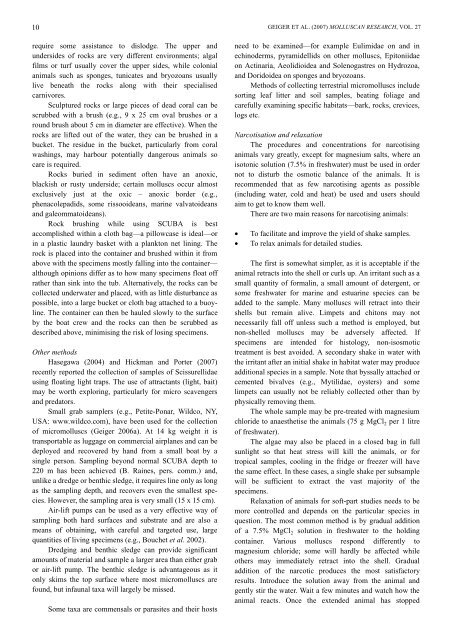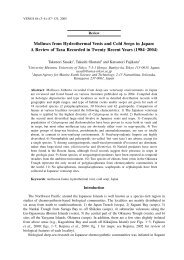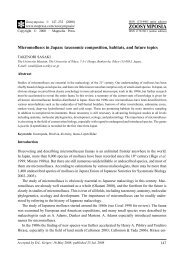Molluscan Research: Techniques for collecting, handling, preparing ...
Molluscan Research: Techniques for collecting, handling, preparing ...
Molluscan Research: Techniques for collecting, handling, preparing ...
You also want an ePaper? Increase the reach of your titles
YUMPU automatically turns print PDFs into web optimized ePapers that Google loves.
10<br />
require some assistance to dislodge. The upper and<br />
undersides of rocks are very different environments; algal<br />
films or turf usually cover the upper sides, while colonial<br />
animals such as sponges, tunicates and bryozoans usually<br />
live beneath the rocks along with their specialised<br />
carnivores.<br />
Sculptured rocks or large pieces of dead coral can be<br />
scrubbed with a brush (e.g., 9 x 25 cm oval brushes or a<br />
round brush about 5 cm in diameter are effective). When the<br />
rocks are lifted out of the water, they can be brushed in a<br />
bucket. The residue in the bucket, particularly from coral<br />
washings, may harbour potentially dangerous animals so<br />
care is required.<br />
Rocks buried in sediment often have an anoxic,<br />
blackish or rusty underside; certain molluscs occur almost<br />
exclusively just at the oxic – anoxic border (e.g.,<br />
phenacolepadids, some rissooideans, marine valvatoideans<br />
and galeommatoideans).<br />
Rock brushing while using SCUBA is best<br />
accomplished within a cloth bag—a pillowcase is ideal—or<br />
in a plastic laundry basket with a plankton net lining. The<br />
rock is placed into the container and brushed within it from<br />
above with the specimens mostly falling into the container—<br />
although opinions differ as to how many specimens float off<br />
rather than sink into the tub. Alternatively, the rocks can be<br />
collected underwater and placed, with as little disturbance as<br />
possible, into a large bucket or cloth bag attached to a buoyline.<br />
The container can then be hauled slowly to the surface<br />
by the boat crew and the rocks can then be scrubbed as<br />
described above, minimising the risk of losing specimens.<br />
Other methods<br />
Hasegawa (2004) and Hickman and Porter (2007)<br />
recently reported the collection of samples of Scissurellidae<br />
using floating light traps. The use of attractants (light, bait)<br />
may be worth exploring, particularly <strong>for</strong> micro scavengers<br />
and predators.<br />
Small grab samplers (e.g., Petite-Ponar, Wildco, NY,<br />
USA: www.wildco.com), have been used <strong>for</strong> the collection<br />
of micromolluscs (Geiger 2006a). At 14 kg weight it is<br />
transportable as luggage on commercial airplanes and can be<br />
deployed and recovered by hand from a small boat by a<br />
single person. Sampling beyond normal SCUBA depth to<br />
220 m has been achieved (B. Raines, pers. comm.) and,<br />
unlike a dredge or benthic sledge, it requires line only as long<br />
as the sampling depth, and recovers even the smallest species.<br />
However, the sampling area is very small (15 x 15 cm).<br />
Air-lift pumps can be used as a very effective way of<br />
sampling both hard surfaces and substrate and are also a<br />
means of obtaining, with careful and targeted use, large<br />
quantities of living specimens (e.g., Bouchet et al. 2002).<br />
Dredging and benthic sledge can provide significant<br />
amounts of material and sample a larger area than either grab<br />
or air-lift pump. The benthic sledge is advantageous as it<br />
only skims the top surface where most micromolluscs are<br />
found, but infaunal taxa will largely be missed.<br />
Some taxa are commensals or parasites and their hosts<br />
GEIGER ET AL. (2007) MOLLUSCAN RESEARCH, VOL. 27<br />
need to be examined—<strong>for</strong> example Eulimidae on and in<br />
echinoderms, pyramidellids on other molluscs, Epitoniidae<br />
on Actinaria, Aeolidioidea and Solenogastres on Hydrozoa,<br />
and Doridoidea on sponges and bryozoans.<br />
Methods of <strong>collecting</strong> terrestrial micromolluscs include<br />
sorting leaf litter and soil samples, beating foliage and<br />
carefully examining specific habitats—bark, rocks, crevices,<br />
logs etc.<br />
Narcotisation and relaxation<br />
The procedures and concentrations <strong>for</strong> narcotising<br />
animals vary greatly, except <strong>for</strong> magnesium salts, where an<br />
isotonic solution (7.5% in freshwater) must be used in order<br />
not to disturb the osmotic balance of the animals. It is<br />
recommended that as few narcotising agents as possible<br />
(including water, cold and heat) be used and users should<br />
aim to get to know them well.<br />
There are two main reasons <strong>for</strong> narcotising animals:<br />
• To facilitate and improve the yield of shake samples.<br />
• To relax animals <strong>for</strong> detailed studies.<br />
The first is somewhat simpler, as it is acceptable if the<br />
animal retracts into the shell or curls up. An irritant such as a<br />
small quantity of <strong>for</strong>malin, a small amount of detergent, or<br />
some freshwater <strong>for</strong> marine and estuarine species can be<br />
added to the sample. Many molluscs will retract into their<br />
shells but remain alive. Limpets and chitons may not<br />
necessarily fall off unless such a method is employed, but<br />
non-shelled molluscs may be adversely affected. If<br />
specimens are intended <strong>for</strong> histology, non-isosmotic<br />
treatment is best avoided. A secondary shake in water with<br />
the irritant after an initial shake in habitat water may produce<br />
additional species in a sample. Note that byssally attached or<br />
cemented bivalves (e.g., Mytilidae, oysters) and some<br />
limpets can usually not be reliably collected other than by<br />
physically removing them.<br />
The whole sample may be pre-treated with magnesium<br />
chloride to anaesthetise the animals (75 g MgCl 2 per 1 litre<br />
of freshwater).<br />
The algae may also be placed in a closed bag in full<br />
sunlight so that heat stress will kill the animals, or <strong>for</strong><br />
tropical samples, cooling in the fridge or freezer will have<br />
the same effect. In these cases, a single shake per subsample<br />
will be sufficient to extract the vast majority of the<br />
specimens.<br />
Relaxation of animals <strong>for</strong> soft-part studies needs to be<br />
more controlled and depends on the particular species in<br />
question. The most common method is by gradual addition<br />
of a 7.5% MgCl 2 solution in freshwater to the holding<br />
container. Various molluscs respond differently to<br />
magnesium chloride; some will hardly be affected while<br />
others may immediately retract into the shell. Gradual<br />
addition of the narcotic produces the most satisfactory<br />
results. Introduce the solution away from the animal and<br />
gently stir the water. Wait a few minutes and watch how the<br />
animal reacts. Once the extended animal has stopped




